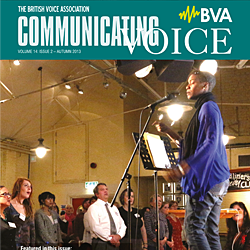About the Association
Van Lawrence Prize 2016
Scaling up: revisiting singers’ pathologies – (abstract)
Miss Abigail Walker, Dr Rachael Craig, Mr Nicholas Gibbins, Mr Tony Aymat, Dr Rehab Awad and Mrs Sara Harris.
Introduction:
Humans have been singing for thousands of years, it is part of who we are as a species. However, until comparatively recently both singers and clinicians have had no information about how they produced the sound and, when their voice went wrong, the reasons why. Manuel Garcia III began to shed light on this area with the realisation that with the inventive use of mirrors one could view the larynx, the movements of the vocal folds and subsequently see pathology when it occurred. Viewing the larynx with a mirror was a great breakthrough but it only afforded a glimpse of the area. With no delicate instrumentation to remove the offending lesions and with speech therapy still some way away, ‘nodules’ became feared by the singing community as a possible end to a career. To this day the mention of nodules instils anxiety in singers, anxiety that needs to be addressed by the clinician.
High definition cameras with stroboscopic or high speed videos to analyse the vocal folds has increased our understanding of the microscopic architecture, and of the physiology of the vocal folds and larynx. However, the thought that vocal fold nodules are common in the dysphonic singer remains. We present the largest study to date in the electronic literature reviewing the pathologies of singers with dysphonia attending a tertiary referral Voice Clinic.
Method:
A comprehensive review of a prospectively maintained database was undertaken at a Voice Clinic that sees over 700 patients a year. The database review covered from Jan 1st, 2010 to Dec 31st, 2015. 271 patients declared their profession as singer or singing student (attending musical college, for example). 16 patients with incomplete notes were excluded. There was no limit on age. A total of 255 patient attendances were included in the study. Patients’ pathologies were classified according to the McGlashan (2006) framework for dysphonia. Some patients had a diagnosis made but at subsequent visits, or if the patient underwent a surgical procedure, the diagnosis changed. In this situation, the final diagnosis was the one used for the analysis.
Results:
138 patients (54%) had one diagnosis, 95 (37%) had two and 22 (9%) had three, giving a total of 394 pathologies. Of the 255 patients, muscle tension imbalance (MTI) was the most common found vocal pathology (120 patients, 47%). However, if only one diagnosis was found, 40% were structural (55 patients) and 38% MTI (52 patients).
Within the structural diagnoses (whether as the only diagnosis or in combination with another), cysts accounted for 33% and oedema 31% of all pathologies. 8 patients had nodules. This represented 9.2% of all structural pathologies but only 3.1% of all attendances. Other structural causes included polyp (8%, 2.7% of total), sulcus (5.7%, 2% of total), scarring (5.7%, 2% of total), haemorrhage, mucosal bridge, granuloma and Reinke’s oedema (all <1%). Inflammatory causes accounted for 17% of single diagnoses (17%)
Conclusions:
Vocal fold nodules have been feared by the singer for decades as it was thought to be indicative of poor technique and possibly career ending. It was thought that nodules were common, however this study shows that nodules in the singer with dysphonia are rare, accounting for 3% of pathologies seen. Singers, singing teachers and voice clinic members should be aware if a mass is seen on the vocal fold in a singer, it is much more likely to be a cyst or oedema than nodules.

 Join us Now!
Join us Now! our newsletter
our newsletter free voice care leaflets & information – download here
free voice care leaflets & information – download here Help our work by donating while you shop
Help our work by donating while you shop